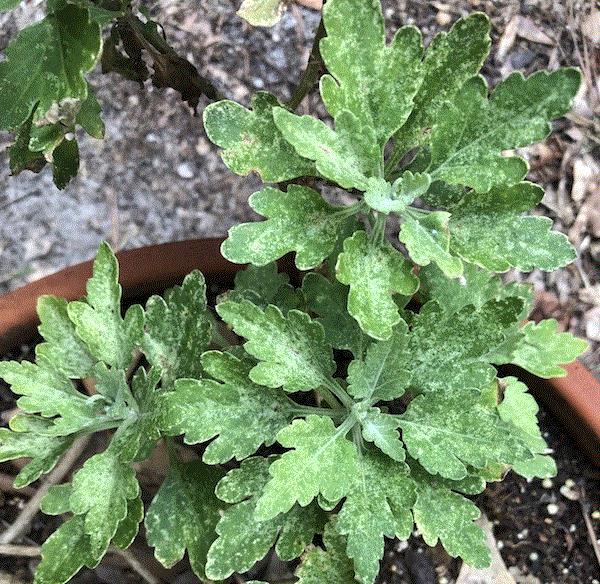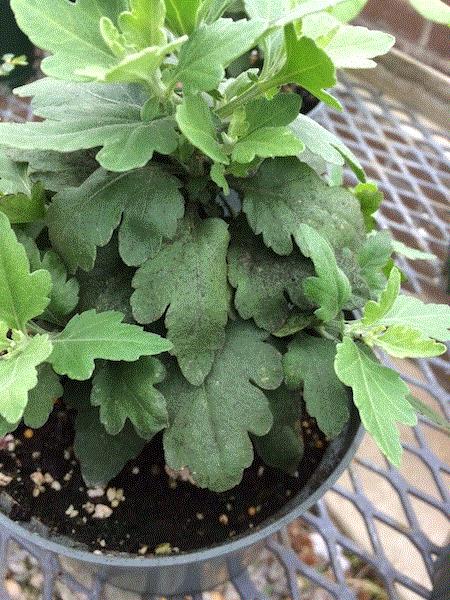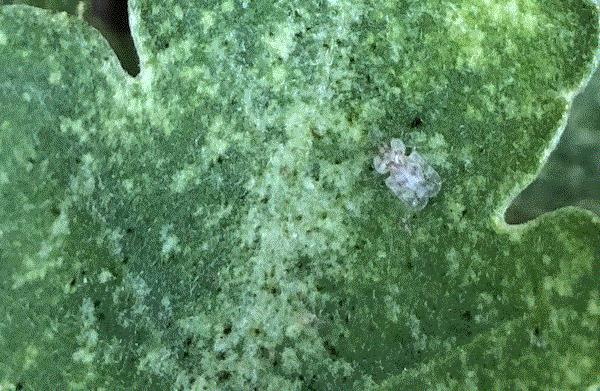What the ... ?
Many people, including my new lab technician (who’s a horticulturist by training), are horrified by my nonchalant mistreatment of plants. Take, for example, a pot of garden mums that was “rescued” from my mother-in-law’s art show by my wife 10 years ago. My lovely wife can do amazing things with a paint brush, but she doesn't have a green thumb.
As a way of dealing with responsibilities that are given to me without my consent, I try to kill the mum with neglect—I don’t water it, I don’t feed it. I hastened its demise by harvesting all its shoots for cuttings for an experiment a couple of years ago. Got bugs? It’ll have to tough it out. After 10 years of abuse, it ain’t as good-looking as it was, but, amazingly, it’s hanging on.
This may be its last year, however. I see its canopy becoming increasingly bleached in the last few weeks. What's the final nail in the coffin of this tough little thing?

Bugs of Mums
We are deep in mum season, so I’ll focus on a few pest management issues today. Let’s start with something a bit more in my wheelhouse ...
Quite a few species of insects and mites infest garden mums, but I get more calls on aphids, caterpillars, thrips and spider mites than any other pests. It’s not to say you don’t have to worry about leafminers, leafhoppers, fungus gnats or tarnish plant bugs. Y’all should familiarize yourself with these occasional pests, know what they look like and the kind of damage they can do. Scout for them and deal with the infestation as soon as possible. Only then will you be able to avoid a spider mite or leafminer outbreak.
Most of us buy cuttings from a propagator. If you're able, I suggest dipping the cuttings in a mixture of 0.5% M-Pede (insecticidal soap) or BotaniGard 22WP (Beauveria bassiana) before sticking. Several studies have shown good suppression of spider mite and thrips population on mums in the weeks following the dip.
My study also showed good suppression of spider mite populations when marigold seedlings are dipped in Hexygon IQ (hexythiazox). See the May issue of this newsletter for information on pre-transplant dips and this technical bulletin on the 2(ee) recommendation of pre-transplant dips with Hexygon. Test for phytotoxicity on a small group of cuttings before dipping.
Fungus gnats are mainly a problem during the rooting stage or when the mums are grown in greenhouses. Sure, you can drench or sprench the media with a neonicotinoid such as Safari (dinotefuran), or with Citation (cyromazine), Adept (diflubenzuron) or Gnatrol (Steinernema feltiae). But the best way to avoid fungus gnat problems is to keep the media on the dry side. Easy said than done when rooting, but try your best.
Melon aphid, green peach aphid and chrysanthemum aphid are the most common aphid species on garden mums. In my opinion, aphids ain’t hard to control. The key is to catch the infestation early; you’re already behind when you can see honeydew and sooty mold on the plants. Set up yellow sticky cards to monitor for movement of winged aphids into the greenhouse. Expect aphids to show up sooner or later if you grow outdoors.
Start a preventive program with a drench of neonicotinoids, or if you can’t use or choose not to use neonics, drench with Altus (flupyradifurone), Kontos (spirotetramat) or Mainspring (cyantraniliprole). These products are also effective when sprayed. But if you already drenched with one of these products, you should spray with products of different modes of action, such as Aria (flonicamid), Endeavor (pymetrozine), Rycar (pyrifluquinazon, for greenhouse only), Ventigra (afidopyropen) and XXpire (sulfoxaflor + spinetoram). Endeavor, Rycar and Ventigra have the same mode of action, so only include one of these in a rotation program.

Start an aphid management program before sooty mold becomes visible.
Caterpillar infestation starts with moths flying into the growing area (often because of attraction by night light). The moths lay eggs and the babies are the caterpillars. I often see cabbage looper and beet armyworm on garden mums, but sometimes southern armyworm, European corn borer and omnivorous leafroller. Screening the greenhouse vents is the first step in stopping the moths from flying in. In field production, avoid nighttime lighting and expect caterpillars to show up at some point in time. Scout regularly to detect chewing damage and poop; these are more readily observable than the caterpillars themselves (which tend to hide during the day).
Acelepryn (chlorantraniliprole) and Mainspring, applied as a spray or drench, had performed very well in my studies against both cabbage looper and beet armyworm. Avid (abamectin; with several generic products), Conserve (spinosad), Sarisa (cyclaniliprole) and XXpire are great options for spray. Bacillus thuringiensis products, such as DiPel Pro, are very effective against small caterpillars. Pylon (chlorfenapyr) is excellent against many caterpillar species, but this product is only registered for greenhouse use.
Thrips can cause stippling on flowers, but this pest can do more damage than that. They can also cause stippling on leaves if not managed and vector viruses such as impatiens necrotic spot virus. I’d seen many western flower thrips, but also eastern flower thrips, onion thrips, echinothrips and several other species on mums both indoors and outdoors.
Thrips is a tough pest, especially for outdoor production because they can be blown in by the slightest wind. As a result, a spray program against thrips can be quite intensive. You can drench the mums with Safari or Mainspring, but this treatment can only provide protection to the leaves. You’ll have to spray to prevent damage on flowers using Avid (or one of the generics) mixed with bifenthrin, Hachi-Hachi (tolfenpyrad), Mainspring, TriStar (acetamiprid) or XXPire. Conserve still works well in my area, but reduced efficacy and perhaps resistance have been reported in other areas. Overture (pyridalyl) and Pylon are good options for thrips management in greenhouses.
Twospotted spider mite can be a big problem on garden mums, especially when the weather is hot and dry. They often avoid detection because of their size, so infestation can easily get out of hand. I’ve often seen infestations start from the lower portion of the plant, perhaps because the mites have to disperse from other crops or weeds nearby, they need time to build up a population.
Management of twospotted spider mite can be a pain later in the crop cycle. A thick canopy makes penetration of spray solutions extremely difficult. Most miticides are very effective, but their efficacy can be discounted when canopy penetration is poor. A higher spray volume and the addition of a spreader-sticker to the spray solution can help with better spray penetration. Some miticides shown to be effective in my studies include Avid, Floramite, Hexygon, Pylon, Savate, Shuttle O and Sultan. Horticultural oil and insecticidal soap can also be effective with shorter reapplication intervals. Let me say it one more time: no, we still don’t have a systemic miticide.
I’ve talked a lot about insecticides and miticides, but don’t forget there are biological control options for these pests, too. Biological control may be a bit easier in greenhouses than outdoor production. I suggest starting biological control programs early in the production cycle. In fact, use biological control as a preventive program and use compatible insecticides only to clean up hots spot or secondary pest outbreaks. A grower I worked with reduced his insecticide spray from 20 down to four in a crop cycle after adopting an aphid banker plant system.

Diseases of Mums
Root, crown and foliar diseases can be rampant after summer rains. High humidity and heat are the exact conditions many pathogens need to proliferate. Once the canopies close in or if the plants aren’t properly spaced, reduced airflow can create a conducive condition for foliar disease development.
I'd seen Pythium and Fusarium wilt take out a whole block of mums grown in a low-laying area. It was likely that irrigation or storm water flow and a sitting pool of water spread the disease. The infected mums looked stunted and discolored, and wilted no matter how much water was applied.

Fusarium wilt often takes out part of a plant. (Photo credit: Penn State Department of Plant Pathology & Environmental Microbiology; bugwood.org.)
The most common foliar diseases of mums I’d seen is Botrytis. Rhizoctonia blight and bacterial leaf spot have also been reported as problems, and chrysanthemum white rust can be a major problem in the cooler North. The epidemiology of foliar disease is intimately linked to moisture and temperature.
A preventive program can be built by understanding which conditions lead to greater disease pressure, and selecting and rotating effective fungicides. I’m not going to wade deep into the pool of fungicides. Instead, I’ll direct you to GrowerTalks’ Insecticide, Miticide, & Fungicide Guide and the Southeastern U.S. Pest Control Guide for Nursery Crops and Landscape Plantings for lists of fungicides for each disease.
Ultimately, a successful disease management program in garden mum production depends heavily on managing moisture, airflow and environmental stress, and predicting weather conditions. You can use the prediction to make appropriate preventive disease-management decisions. Therefore, the pests and diseases I’d talked about today are most effective managed with an agronomic approach, that is, to include the management of all the pests and diseases as part of the crop production system. No greenhouse or nursery operate in the exact same way, so the agronomic approach is, of course, unique to each operation.
Here are some thoughts from Nancy Rechcigl of Syngenta on how to build an agronomic approach to pest management in mum production.

Weeds in Mums
I don’t really know what to tell you about weeds in mums because I don’t see many weeds in or around the pots. Groundcover fabric and weed barrier usually do a good job of reducing weed presence and growth in outdoor production. Clean media, clean pots and impeccable weed management in the growing area is critical to reducing weeds and weed management costs.
Several pre-emergent herbicides are available for various broadleaf and grassy weed species. Again, consult your local extension specialists or the Southeastern U.S. Pest Control Guide for Nursery Crops and Landscape Plantings for available herbicides. Read the labels carefully for target species, tolerance in mums and timing of application.
Typically, pre-emergent herbicides are applied to the media surface after the cuttings have established. If there's any breakthrough, hand weeding is the best way to eliminate weeds in the pots. Weeds usually stop being a problem once the canopy grows over the pots.
Answer to "What the ... ?"
I bet you haven’t seen a chrysanthemum lacebug before. Maybe you have, but not frequently. It’s an occasional pest of garden mums. I’ve never seen chrysanthemum lacebug causing any issues in garden mum production before.
Pretty little bug. Similar to other lacebug species, the chrysanthemum lacebug has an expanded and finely sculptured thorax and wings. They use their piercing-sucking mouthpart to feed on individual cells, which causes pale stippling or speckling on the infested leaves. When the plants are severely infested, as in the case of my 10-year-old mum, the leaves can become bleached.

Insecticides that are effective against other lacebug species, such as azalea lacebug, should be effective against chrysanthemum lacebug. But I don’t think I’ll treat for them. The mum looks horrible, but the bugs are pretty cool. I’ll keep those bugs around.
See y'all later!

JC Chong
Professor of Entomology at Clemson University
This e-mail received by 27,318 subscribers like you!
If you're interested in advertising on PestTalks contact Kim Brown ASAP!